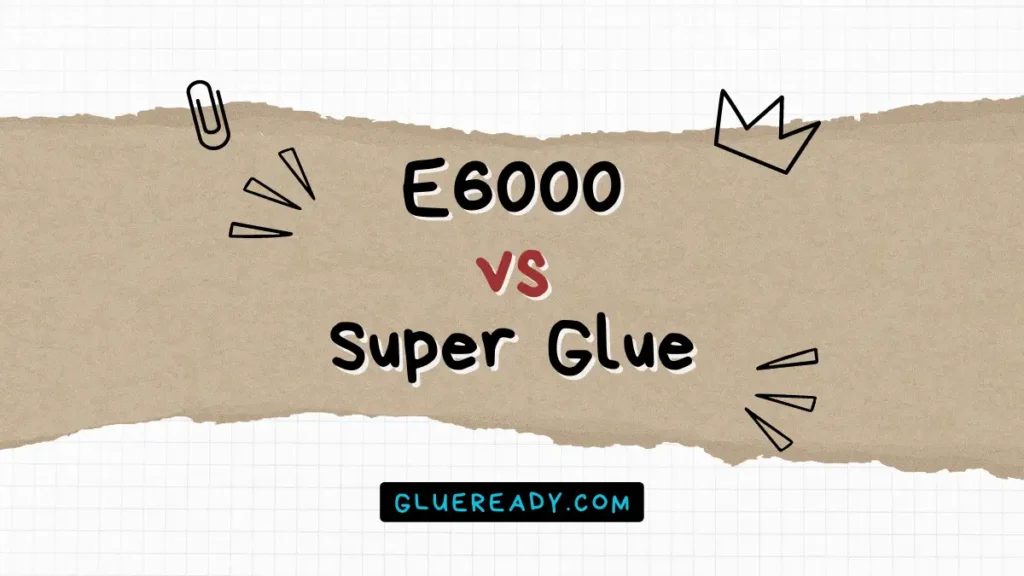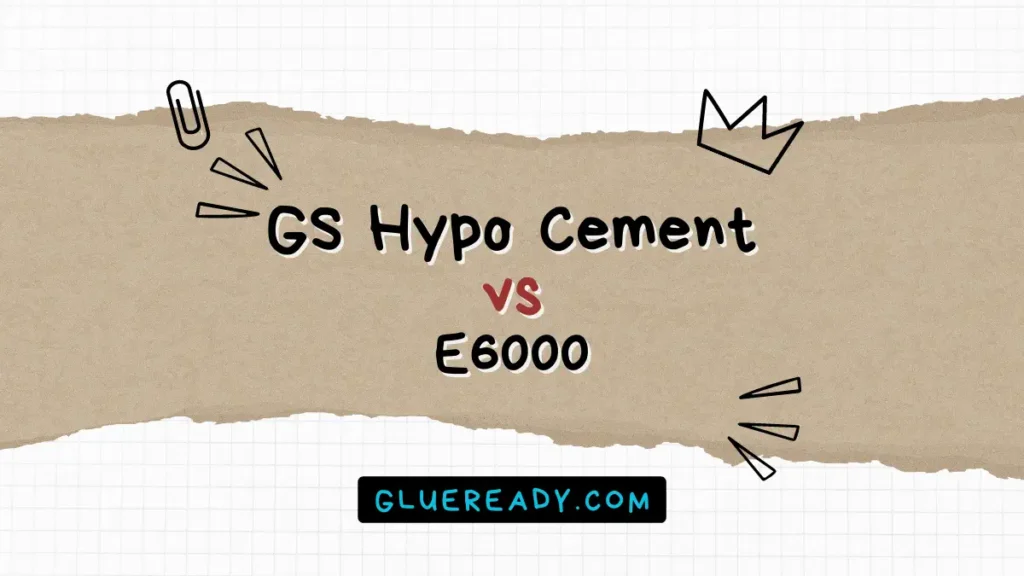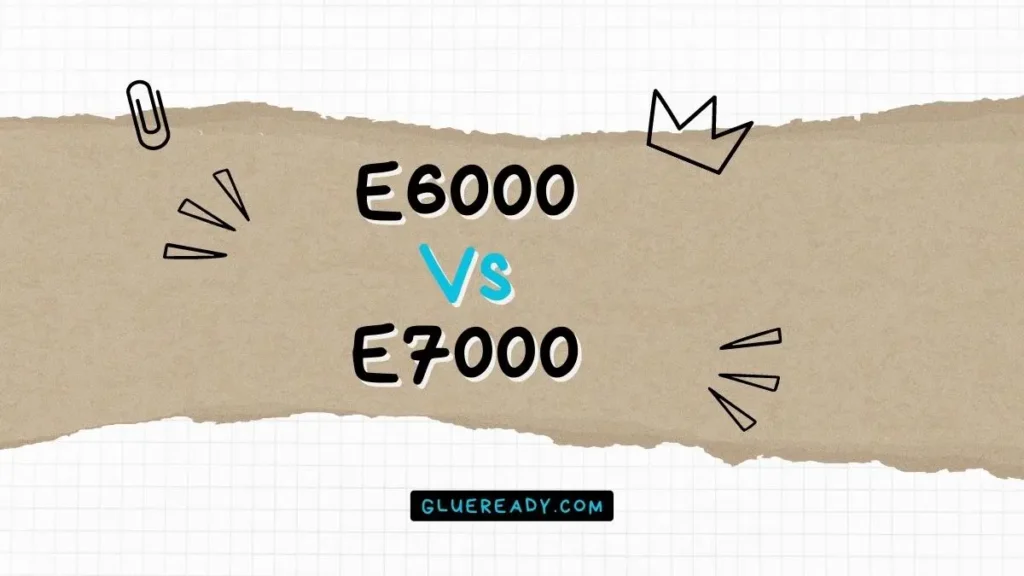Hot Glue vs E6000 | In-Depth Analysis

If you are a crafter, you know how important it is to have good glue for your projects. Two of the most popular glues among crafters are hot glue and E6000 glue.
Hot glue is better for quick and easy projects that involve porous and rough surfaces. E6000 glue is better for complex and durable projects that involve smooth and non-porous surfaces.
In the battle between Hot Glue vs E6000, I will help you to find a suitable solution for your projects.
Read More: Goop Glue vs E6000
Overview of Hot Glue
Hot glue is a thermoplastic adhesive that comes in the form of solid sticks. To use it, you need a glue gun device that heats up the stick and melts the glue.
You can then apply the glue to the surface you want to bond and press it with another surface. The glue cools down and hardens quickly, forming a solid bond.
Hot glue is ideal for bonding porous and rough surfaces, such as wood, paper, fabric, shells, and some plastics. It is also great for filling gaps or textured areas.
Hot glue is easy to manipulate and directs where the glue goes. You can even write or make designs with it. Hot glue dries clear and delivers a strong bond.

Overview of E6000 Adhesive
E6000 glue is an industrial-strength adhesive that comes in the form of a clear liquid. To use it, you need to squeeze out a small amount of glue from the tube and apply it to the surface you want to bond. You can then press it with another surface and let it cure for 24 hours.
E6000 glue is suitable for bonding various materials, such as rubber, metal, glass, leather, vinyl, wood, ceramics, and more.
It is a flexible adhesive that can withstand vibration, shock, and temperature changes.
E6000 glue is water-resistant, chemical-resistant, acid-resistant, and dilute base-resistant. It is also non-flammable, paintable, and washer/dryer safe.

Hot Glue vs E6000 Adhesive Comparison Table
| Feature | Hot Glue | E6000 |
| Form | Solid stick | Liquid tube |
| Device | Glue gun | None |
| Usage | Porous and rough surfaces | Smooth and non-porous surfaces |
| Strength | Mechanical bond | Chemical bond |
| Drying time | Seconds | 24 hours |
| Flexibility | Rigid | Flexible |
| Water-resistance | Moderate | High |
| Chemical-resistance | Low | High |
| Heat-resistance | Low | High |
| Safety | Low risk of burns | High risk of toxicity |
Comparison Between Hot Glue and E6000 Adhesive
Hot glue and E6000 are both high-quality adhesives that can be used for various crafts. However, they have some differences that make them more suitable for certain situations. Here are some factors to consider when choosing between hot glue and E6000:
Usage
Hot glue is ideal for bonding uneven surfaces that mate well together. It can fill gaps or textured areas and create a strong bond between porous and rough materials.
However, it is not very effective for bonding smooth or non-porous surfaces, such as glass or metal. It also loses its strength when exposed to high temperatures or humidity.
E6000 is more compatible with smooth and non-porous surfaces, such as glass and metal. It can create a permanent bond that can withstand pressure and stress.
However, it is not very good for filling gaps or textured areas. It also takes longer to dry and cure than hot glue.
Ease of Use
Hot glue is easy to use with a glue gun. You just need to insert the glue stick into the gun, heat it up, and apply it to the surface you want to bond.
It dries quickly and allows you to adjust the position of the pieces before it sets.

E6000 is also easy to use with a tube. You just need to squeeze out the glue onto the surface you want to bond and press the pieces together.
However, it takes longer to dry and cure than hot glue. You also need to be careful not to get it on your skin or eyes.
Safety
Hot glue is relatively safe to use as long as you avoid burning yourself with the hot glue gun or the molten glue. You should also keep it away from children and pets who might ingest it.
E6000 is more hazardous to use because it contains PCE, a toxic solvent that can cause headaches, dizziness, nausea, irritation of the eyes and respiratory tract, liver damage, kidney damage, etc.
The best way to use E6000 is to use it in a well-ventilated area with gloves and eye protection on. You should also keep it away from children and pets who might ingest it.
Cost
Hot glue is cheaper than E6000. You can buy a pack of hot glue sticks for around $3-$10, depending on the size and quantity. A glue gun costs around $10-$20, depending on the quality and features.
E6000 is more expensive than hot glue. You can buy just a tube of E6000 for around $3-$10, depending on the size and quantity.
Read More: Gem Tac vs E6000
How to Choose Between Hot Glue and E6000 Adhesive?
Hot glue and E6000 are both great adhesives for your crafts, but they have different strengths and weaknesses. You should choose the one that best suits your needs and preferences. Here are some general guidelines to help you decide:
Use hot glue if you want to bond porous and rough surfaces, such as wood, paper, fabric, shells, etc. It is also good for filling gaps or textured areas and creating a strong bond quickly and easily.
Use E6000 if you want to bond smooth and non-porous surfaces, such as glass, metal, leather, vinyl, plastic, etc. It is also good for creating a permanent bond that can withstand pressure and stress.
E6000 is especially suitable for heavy-duty applications and projects that require long-lasting results. Use hot glue for lightweight projects, temporary fixes, and applications that require quick bonding and easy reversibility.
You can also use both hot glue and E6000 together for some projects. For example, if you want to bond metal to glass, you can use E6000 for the main bond and hot glue for the edges or corners. This way, you can get the best of both worlds.
Whatever glue you choose, make sure to follow the instructions and safety precautions carefully.
Can I Use E6000 and Hot Glue Together?
Yes, you can use E6000 and hot glue together for some projects. You can mix a bit of hot glue with E6000 to get a faster drying and long-lasting formula.
You can also use hot glue for ease of placement and then use E6000 for a permanent hold. However, you should be careful when using both glues together, as they have different properties and may not be compatible with all materials.
Is Hot Glue Stronger Than E6000?
No, hot glue is not stronger than E6000. E6000 has a tensile strength of 3500 lbs/in², while hot glue has a tensile strength of 377 lbs/in².
E6000 is also more resistant to heat, water, chemicals, and impact than hot glue. Hot glue is only stronger than E6000 in terms of bond speed and gap filling.
What Does Hot Glue Not Stick To?
A very smooth, wet, or greasy surface, such as vinyl, silicone, wax, metal, or oil will not adhere to hot glue.
Final Thoughts
Hot glue is quick, versatile, and reversible, making it suitable for lighter projects and temporary fixes.
On the other hand, E6000 offers strength, durability, weather resistance, and flexibility, making it a preferred option for heavy-duty applications and permanent bonds.
Both hot glue and E6000 have their advantages and ideal use cases. Hopefully, now after reading this comparison between Hot Glue vs E6000, now you have a clear idea about which one to use for your projects.






